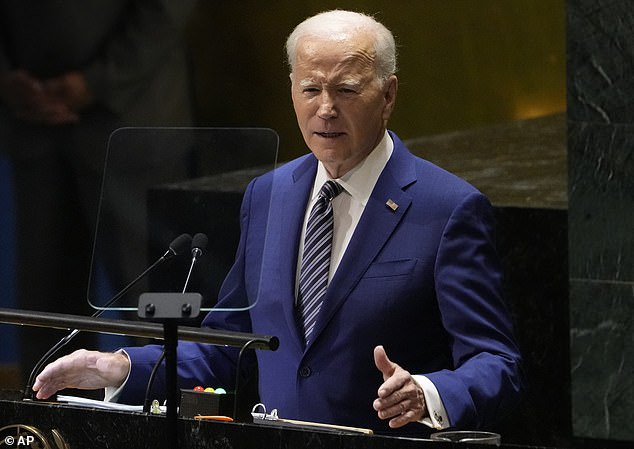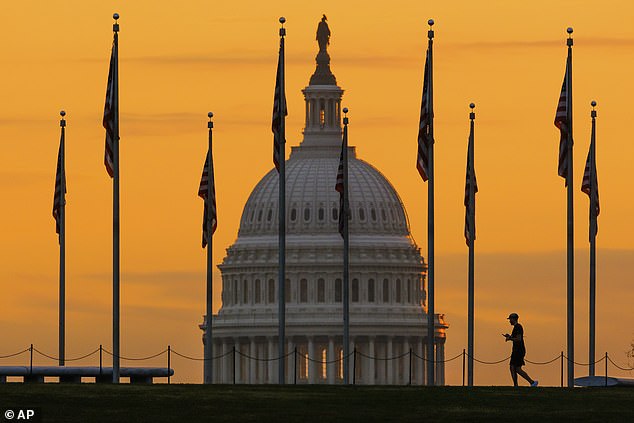US National Debt Hits $33 Trillion for the First Time in History – as Congress Heads for a Shutdown in Just 11 DAYS
US National Debt Hits $33 Trillion for the First Time in History – as Congress Heads for a Shutdown in Just 11 DAYS
- According to the Treasury Department, the US national debt reached $33 trillion for the first time
- The Finance Minister said she was not yet concerned because the interest rate was ‘reasonable’
- Congress must fund the government by September 30 to avoid a shutdown
The US national debt has topped $33 trillion for the first time as lawmakers scramble to avoid a government shutdown at the end of the month.
The Treasury Department noted that debt reached $33.04 trillion on Monday, meaning it has risen by $1.58 trillion since the debt ceiling was lifted in early June.
After years of extreme spending, the country reached its $31.4 trillion debt ceiling in January and months later, in May, President Biden and House Speaker Kevin McCarthy agreed to suspend the ceiling until January 2025.
Although the cap has now been lifted, Congress must continue to find ways to fund the government.
The funding runs until September 30, but after that new legislation will be needed.
The US national debt has exceeded $33 trillion for the first time, the Treasury Department noted on Monday

Since President Biden and House Speaker Kevin McCarthy agreed to suspend the debt ceiling in June, the budget deficit has increased by $1.58 trillion.
That solution will require bipartisan support in the House of Representatives, as there are still some Republicans in the House of Representatives who are unlikely to approve any expansion of government spending.
On Sunday, six Republicans announced a proposal to temporarily fund the government until October 31.
That proposal calls for cutting the budgets of government agencies — with the exception of the Department of Defense and the Department of Veterans Affairs — by 8 percent through the end of October.
It was sponsored by members of the conservative House Freedom Caucus and the Main Street Caucus, but some conservatives already opposed it.
That bill is also likely to be killed by the Democratic-controlled Senate because it requires spending cuts and caps.
But Treasury Secretary Janet Yellen said Monday that while deficits need to be kept under control, she is not particularly concerned about the $33 trillion figure.
“The metric or metric I look at most often to assess our fiscal stance is net interest as a percentage of GDP and even with the rate hike we’ve seen, that remains at a very reasonable level of around 1 percent,” she says. told CNBC.

Treasury Secretary Janet Yellen said Monday that while the deficit needed to be kept under control, government debt yields remained at reasonable levels relative to U.S. GDP. She was pictured at the Committee on Foreign Investment at the US conference last week

Congress must fund the government after September 30 to avoid a shutdown at the end of the month. Pictured is the US Capitol in Washington DC
The $33 trillion federal debt consists of $26 trillion in debt owed by the public and $7 trillion in debt held in government bonds such as U.S. pension funds and the Social Security Trust Fund.
“The United States has reached a new milestone that no one can be proud of: our gross national debt just surpassed $33 trillion,” Maya MacGuineas, chair of the Committee for a Responsible Federal Budget, wrote in a news conference. Edition.
“The public’s debt recently exceeded $26 trillion. We become numb to these enormous numbers, but that doesn’t make them any less dangerous.’
Since 2001, the government has run a deficit of about $1 trillion every year. This includes spending on social safety net programs, interest on debt, and military financing.
Recently, the national debt has increased due to the Covid-19 pandemic. The latest findings from the Congressional Budget Office suggest that the national debt will almost double in size over the next thirty years.
“As lawmakers drift from one short-term budget crisis to the next, our national debt continues to pile up, trillion after trillion,” Michael Peterson, CEO of the Peter G. Peterson Foundation, said in a statement.
“After the debt ceiling showdown in June, we passed the $32 trillion debt milestone. Now, as we face a possible government shutdown just three months later, we have passed $33 trillion in red ink.”
